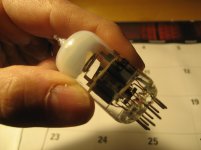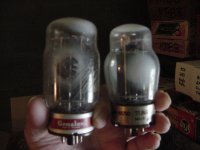I turned on my system this am to hear a nasty hum...both speakers. I quickly shut everything off and swapped preamp - all was fine - no hum. I looked at my preamp (Aikido all in one 6922/6H30) closer and found one of the two 6922 input tubes smoked on top - after looking a little closer saw a gaping hole in bottom of tube at the knuckle...what the hell would cause this? I am glad I did not destroy anything in my system....replaced the EH6922 and all good again..
See pic... bad manufacturing defect? The pre has not been moved for months....
See pic... bad manufacturing defect? The pre has not been moved for months....
Attachments
Suspect other members of your household...
I have them trained to simply tell me if something was damaged. Its far cheaper in the long run and I myself have broken enough things through foolish mistakes.
Then again.. do you have a cat?
The tube must have drawn air somehow. A bent pin will do that sometimes...
I'm thinking that little hole near the bottom has something to do with it.
Now we just have to solve the mystery. Who in John's place is the culprit and what was their motive?
hehe
Strange though, how electronics and componenets have evolved. When I started working back in -75, MTBF figures for units and components were serious business. It also happened that we actually repaired stuff  , opposit of today where we mostly change and throw away the faulty stuff...... MTBF is just statistics these days.
, opposit of today where we mostly change and throw away the faulty stuff...... MTBF is just statistics these days.
Good old glass bubbles are still much the same, though..... they still fail from time to time...
Good old glass bubbles are still much the same, though..... they still fail from time to time...
Cat-O-strophic tube failure
One chilly October some years ago, one of my amplifiers began to blow output tubes in for no apparent reason.
Much head-scratching ensued - no obvious culprit, filament and HV looked correct, bias and grid current matched the amp's specs - but some unknown agent was causing the tube glass to crack and leak.
Finally found the culprit while dozing in my chair - 'POP!' an EL34 went gunnysack and the music gurgled to a halt.
Our the old grey cat was sleeping on top of the amp, and in his dotage was beginning to drool - yup, right onto a hot tube - *SIGH!*
The solution was to build him a padded shelf above the amps where he could bliss-out in comfort while the music continued to play.
Tubes suffer a surprising variety of insults - as long as nothing in the surrounding circuit looks toasty, bulged, or burned you're probably good to go.
Cheers
Jim
One chilly October some years ago, one of my amplifiers began to blow output tubes in for no apparent reason.
Much head-scratching ensued - no obvious culprit, filament and HV looked correct, bias and grid current matched the amp's specs - but some unknown agent was causing the tube glass to crack and leak.
Finally found the culprit while dozing in my chair - 'POP!' an EL34 went gunnysack and the music gurgled to a halt.
Our the old grey cat was sleeping on top of the amp, and in his dotage was beginning to drool - yup, right onto a hot tube - *SIGH!*
The solution was to build him a padded shelf above the amps where he could bliss-out in comfort while the music continued to play.
Tubes suffer a surprising variety of insults - as long as nothing in the surrounding circuit looks toasty, bulged, or burned you're probably good to go.
Cheers
Jim
Hi Jim,
You are lucky with that cat. They normally do something else far more destructive and unappealing. They love warm equipment and tend to completely relax.
The resulting fluid will gel if you leave it. Washing the equipment out leaves all the odor in all its glory, plus a bunch of lead-less parts. I wonder, is coke the worst thing to spill inside equipment? You be the judge.
-Chris
You are lucky with that cat. They normally do something else far more destructive and unappealing. They love warm equipment and tend to completely relax.
The resulting fluid will gel if you leave it. Washing the equipment out leaves all the odor in all its glory, plus a bunch of lead-less parts. I wonder, is coke the worst thing to spill inside equipment? You be the judge.
-Chris
Hi AuroraB,
Not really. 35 + years in service and I am glad I don't have to deal with cat killed audio anymore. Nasty stuff!
Why do people wait until it dries or gels instead of getting into service straight away? Waiting is more destructive, and worse for the tech.
-Chris
Not really. 35 + years in service and I am glad I don't have to deal with cat killed audio anymore. Nasty stuff!
Why do people wait until it dries or gels instead of getting into service straight away? Waiting is more destructive, and worse for the tech.
-Chris
Hi AuroraB,
Not really. 35 + years in service and I am glad I don't have to deal with cat killed audio anymore. Nasty stuff!
Why do people wait until it dries or gels instead of getting into service straight away? Waiting is more destructive, and worse for the tech.
-Chris
The Firstwatt manuals contain this advice:
"If you spill a drink in the amplifier
or if your dog/cat/child urinates on it, turn it off immediately, unplug it,
and do not operate it until cleaned by a qualified technician."
It sounds like this happens more often than I would have guessed.
Perhaps people don't know it happened or maybe they wishfully think it'll be OK
once it dries up?
Dennis
- Status
- This old topic is closed. If you want to reopen this topic, contact a moderator using the "Report Post" button.
- Home
- Amplifiers
- Tubes / Valves
- What the hell caused this?



